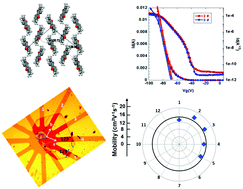In-plane isotropic charge transport characteristics of single-crystal FETs with high mobility based on 2,6-bis(4-methoxyphenyl)anthracene: experimental cum theoretical assessment†
Abstract
In-plane isotropic charge transport in single crystals is desirable in large-area single-crystal thin-film transistor (FET) arrays because it is independent of crystal direction. However, most organic semiconductors show anisotropic charge transport, while only a few show isotropic or moderately isotropic charge transport characteristics. We report a highly isotropic charge transport semiconductor material, 2,6-bis(4-methoxyphenyl)anthracene (BOPAnt), and demonstrate BOPAnt-based single-crystal FETs with a high mobility of 13–16 cm2 V−1 s−1 and an anisotropic mobility ratio (μmax/μmin) of approximately 1.23, the lowest value yet reported. Using the single-crystal structure of BOPAnt, the rectangular diffraction patterns of the molecular lattice parameters in single-crystal thin films were analysed by transmission electron microscopy and polarized optical microscopy. The highly isotropic properties are attributed to the molecular structure enhancement by incorporation of methoxyphenyl units; our analysis revealed an orthorhombic lattice arrangement in the solid state, with the molecules packed in an unusual fashion in this particular stacking mode. In addition, hole mobility calculations combining the transfer integrals and the reorganization energy are used to explain the charge-transport properties.



 Please wait while we load your content...
Please wait while we load your content...